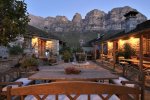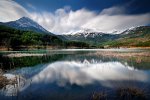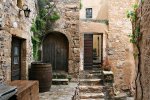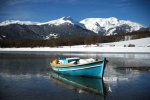An island made of lava and water, with outstanding beauty, unique atmosphere, and intense energy. It was created and destroyed many times until it acquired its final form, a form which has been much admired and loved. Everything was created in an artistic way - simple lines, sweet curves, pure white shapes with brushstrokes of vivid colors, a mirage of the equally vivid dynamics of the scenery. This is Santorini! The volcanic element is visible everywhere, in the colorful volcanic rocks, the black beaches and, of course, the famous caldera. An island closely connected with the volcano - its creator, but also its destroyer.
Santorini is an arid island which, due to its soil as well as the high levels of humidity, is famous for its produce of fine quality and flavor: the cherry tomato, fava beans, capers and the king of all, the vineyards that produce the famous wine of Santorini.
Besides the natural beauty of the region, of particular interest is its architecture, which is directly connected to the volcanic dust, since the cave buildings are constructed in the soft but solid Theran earth, the “aspa”. The Theran earth is an excellent building material and was used for the construction of the Suez Canal, and the ruins of the mines are still visible. White facades of houses are perched on the edge of the caldera and beneath the steep, russet rocks.
The history of Santorini is long. The archaeological findings take us back to 3000 BC and to the first signs of habitation on the island in the Early Cycladic civilization. Archaeologists have unearthed part of a highly developed settlement at the southern part of the island, in Akrotiri. It is filled with Minoan features enriched with the unique features of the Cycladic civilization. The wealth and the development of the settlement during that time are obvious. There are high constructions, house mural paintings of unique beauty, pottery and furniture of daily life, as well as the town plan and the sewage system. Until then, according to Herodotus, the island was called Strogili, because its shape was circular, and it was joined with modern Therasia and Aspronisi. In the Scriptures it is also mentioned as Kallisti (because of its beauty), Filotera etc.
However, this thriving civilization disappeared suddenly in approximately 1650 BC, with the great eruption of the volcano. Archaeologists, not having found any human evidence, concluded that the inhabitants were aware of the eruption and left the island. The eruption was one of the biggest globally and the tidal wave that was caused probably constituted the cause of the extinction of the Minoan civilization. Santorini was deserted until the 13th century BC, when it became inhabited by the Phoenicians. The Lacedaemonians followed (approximately in 1115 BC) with Theras as their leader, who was the viceroy of Sparta and great-great-grandson of Oedipus, and who gave his name to the island. Thira entered a period of growth with the adoption of the Greek alphabet (with Crete and Milos), created its own colony in Libya, in Cyrene, and minted its own currency, having two dolphins as a symbol. During the Peloponnesian war it took the side of Sparta, while due to its location it was a military base both for Alexander the Great and for Ptolemy. With the 4th Crusade it passed to the hands of the Duchy of Naxos. During this period it acquired the name by which it has been known until today, Santorini, from Santa Irini, probably because of a Christian church that existed on the island. In times of pirate attacks, castles were created, the famous castles of Santorini. Its history does not lack the invasion by the Turks (1579-1821), with Santorini participating in the revolution of 1821, with captain Evangelos Matzarakis as its leader. In 1830 Santorini was united with Greece. In recent history, it was occupied by Italian and German forces until its liberation. Nowadays, Santorini is included in the best travel destinations globally. It is famous for its unique beauty, sunsets and atmosphere.
Use the map or the alphabet below to find your favorite destination!
Achaea Prefecture
Aegina
Aetoloakarnania Prefecture
Agathonisi
Agistri
Alonissos
Amorgos
Anafi
Andros
Antiparos
Arcadia Prefecture
Argolida Prefecture
Arta Prefecture
Astypalea
Attiki Prefecture
Kalymnos
Karditsa Prefecture
Karpathos
Kasos
Kastelorizo
Kastoria Prefecture
Kavala Prefecture
Kea (Tzia)
Kefalonia
Kerkyra (Corfu)
Kilkis Prefecture
Kimolos
Korinthia Prefecture
Kos
Koufonisi (Ano & Kato)
Kozani Prefecture
Kythira - Antikythira
Kythnos
Samos
Samothrace
Santorini
Schinoussa
Serifos
Serres Prefecture
Sifnos
Sikinos
Skiathos
Skopelos
Skyros
Spetses
Symi
Syros
Would you like to combine skiing in the morning and then go swimming in the afternoon, all in one region? Click to choose your interests and see in which part of Greece you enjoy them. Combinations are endless!










